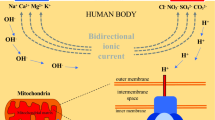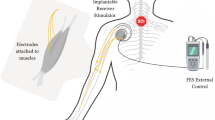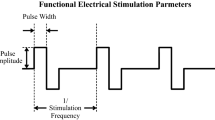Abstract
Functional Electrical Stimulation (FES) is a technology to generate neural activity in an artificial way to activate muscles. However, as reported by some researchers, the human responses to FES are likely to be affected by several factors, such as spasticity, muscle fatigue, nerve habituation and so forth. Consequently, the function restoration by FES is neither durable, nor stable. In order to realize long-term and stable FES assistance, this study investigated whether and why an Auxiliary Stimulation (AS) to the Gastrocnemius, with current frequency ranged from 2000 to 6000 Hz, could alleviate the symptom of spasticity and muscle fatigue caused by the stimulation to the Tibialis Anterior. We have developed a portable auxiliary stimulator, and performed experiments to verify its effectiveness. The results showed that our approach enabled comparatively stable and durable function restoration assistance. Moreover, for understanding underlying neuromuscular processes elicited by the AS and its qualitative nature, this study also measured the Hoffmann-reflex (H-reflex) in soleus muscle before and after the AS, to interpret the effect of the Auxiliary Stimulation.













Similar content being viewed by others
References
Hambrecht, F. T., and Reswick, J. B., Functional Electrical Stimulation Application in Neural Prosthesic. Marcel Dekker, 1977.
Liberson, W. T., Functional electrotherapy stimulation of the peroneal nerve synchronized with the swing phase of the gait of the hemiplegic patients. Arch. Phys. Med. Rehabil. 42:101–105, 1961.
McNeal, D. R., Analysis of a model for excitation of my elinated nerve. IEEE7kms. Biomd. Eng. 23:329–337, 1976.
Handa, Y., and Hoshimiya, N., Functional electrical stimulation for the control of the upper extremities. Med. Pro. Technology 12:51–63, 1980.
Lance, J. W., Symposium synopsis. In: Feldman, R. G., Young, R. R., and Koella, W. P. (Eds.), Spasticity: Disordered Motor Control. Year Book Medical, St Louis, pp. 485–494, 1980.
Katz, R. T., and Rymer, W. Z., Spastic hypertonia: Mechanisms and measurement. Arch. Phys. Med. Rehab. 70:144–155, 1989.
Kinya, F., Feasibility of physiome-based functional electrical stimulation, IEICE technical report. ME and Bio Cybernetics. 102(728):17–20, 2003.
Matsunaga, T., Shimada, Y., and Sato, N., Muscle fatigue from intermittent stimulation with low and high frequency, electrical pulses. Arch. Phys. Med. Rehabil. 80:48–53, 1999.
Thomas, F., Jochen, Q., Robert, R., and Günther, S., Walking with walk! IEEE Eng. Med. Biol. Mag. 10:38–48, 2008.
Makoto, M., Relationship between AFO and Neurological Organization in Spastic Hemiplegia. Jpn. Phys. Ther. Assoc. 27(5):145–150, 2000.
Bogataj, U., Gros, N., Kljajic, M., Acimovic, R., and Malezic, M., A comparison between conventional therapy and multichannel functional stimulation therapy, rehabilitation of gait in patients with hemiplegia. Phys. Ther. 75:490–502, 1995.
Albright, A. L., Neurosurgical treatment of spasticityand other pediatric movement disorders. J. Child Neurol. 18(1):67–78, 2003.
Bakhtiary, A. H., and Fatemy, E., Does electrical stimulation reduce spasticity afterstroke? A randomized controlled study. Clin. Rehabil. 418–425, 2008.
Hazlewood, M. E., Brown, J. K., Rowe, P. J., and Sao, F., Therapeutic electrical stimulation in the treatment of hemiplegic cerebral palsy. Dev. Med. Child Neurol. 36(8):661–673, 1994.
Kralj, T., and Grobelnik, B., T-10 paraplegic patient walking in parallel bars, 1979
Masuda, M., Kiyoshige, Y., and IHASHI, K., Influence of therapeutic electrical stimulation on contractile properties of human paralyzed muscles. Jpn. Phys. Ther. Assoc. 25(3):121–127, 1998.
Hoffmann, P., Beitrag zur Kenntnis der menschlichen Reflexe mit besonderer Berucksichtigung der elektrischen Erscheinungen. Arch. Anat. Physiol. 1:223–246, 1910.
Magladery, J. W., and McDougal, D. B., Electrophysiological studies of nerve and reflex activity in normal man, I: Identification of certain reflexes in the electromyogram and the conduction velocity of peripheral nerve fibers. Bull. Johns Hopkins 86:265–289, 1950.
Riann, M. P., Christopher, D. I., and Mark, A. H., The Hoffmann reflex: Methodologic considerations and applications for use in sports medicine and athletic training research. J. Athl. Train. 39(3):268–277, 2004.
Iwatsuki, H., Effects of vibratory stimulation on antagonist motoneuron excitability under different frequencies. J. Jpn. Phys. Ther. Assoc. 18(1):41–44, 1991.
Sköld, C., Lönn, L., Harms-Ringdahl, K., Hultling, C., Levi, R., Nash, M., and Seiger, A., Effects of functional electrical stimulation training for six months on body composition and spasticity in motor complete tetraplegic spinal cord-injured individuals. J. Rehabil. Med. 34:25–32, 2002.
Levin, M. F., and Hui-Chan, C., Are H and stretch reflexes in hemiparesis reproducible and correlated with spasticity? J. Neurol. 240:63–71, 1993.
Reboul, J., and Rosenblueth, A., The action of alternating currentsupon the electrical excitability of nerve. Am. J. Physiol. 125:205–215, 1939.
Bowman, B. R., and McNeal, D. R., Response of single alpha motoneurons to high-frequency pulse train: Firing behavior and conduction block phenomenon. Appl. Neurophysiol. 49:121–138, 1986.
Author information
Authors and Affiliations
Corresponding author
Rights and permissions
About this article
Cite this article
Yuan, B., Sun, G., Gomez, J. et al. The Effect of an Auxiliary Stimulation on Motor Function Restoration by FES. J Med Syst 35, 855–861 (2011). https://doi.org/10.1007/s10916-010-9517-9
Received:
Accepted:
Published:
Issue Date:
DOI: https://doi.org/10.1007/s10916-010-9517-9




